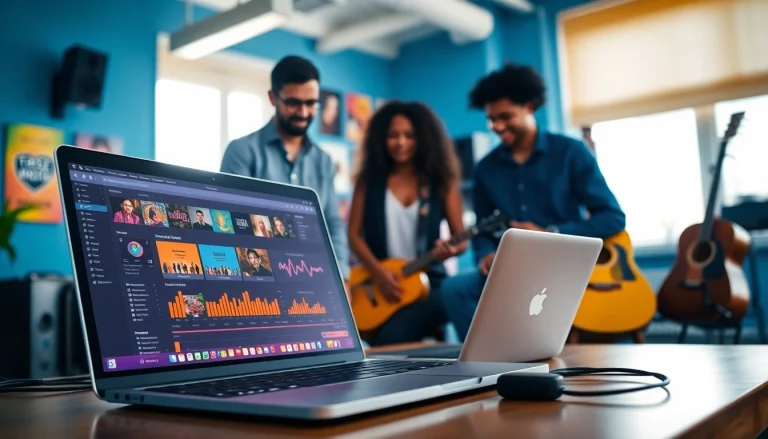
Understanding Music Pitching
Music pitching is a crucial aspect of the modern music industry, where artists, managers, and promoters work tirelessly to get their songs in front of the right audience. With platforms like Spotify, Apple Music, and various music blogs acting as gatekeepers, understanding the nuances of music pitching is essential for any musician looking to break through the noise. In this comprehensive guide, we will delve into the intricacies of music pitching—uncovering its purpose, crafting effective pitches, exploring key platforms, and applying best practices to ensure success.
What is Music Pitching?
At its core, music pitching refers to the process of presenting a song or an artist’s work to curators, playlist makers, record labels, radio stations, or other industry influencers with the intent of gaining exposure. This process can include submitting music for playlist consideration, sending demos to record labels, or trying to get coverage from music blogs and magazines. It aims to position the artist within a competitive landscape, seeking opportunities that may elevate their career.
The Importance of Effective Music Pitching
In an age where millions of songs are released each year, the ability to effectively pitch your music can make or break a budding artist’s career. Effective music pitching helps artists to:
- Gain Access to Wider Audiences: By reaching out to playlist curators or influencers, artists can introduce their music to potential fans.
- Establish Industry Connections: Building relationships with curators, bloggers, or label representatives can lead to future collaborations and opportunities.
- Improve Brand Visibility: Regularly pitching music helps to maintain relevance in the industry, showcasing an artist’s developments and releases.
Common Misconceptions About Music Pitching
Despite its importance, several misconceptions about music pitching can hinder an artist’s efforts:
- Pitches Should Be One-Size-Fits-All: Many believe that a generic pitch can be sent to numerous contacts without personalization. In reality, tailored pitches often yield better results.
- Only Established Artists Can Get Playlist Placements: Independent artists can and have successfully placed their music on playlists through strategic pitching techniques.
- Quantity Over Quality: Artists often feel that sending out a high volume of pitches increases their chances of success. However, thoughtful, quality pitches are more effective than merely overwhelming curators with submissions.
Crafting Your Music Pitch
Elements of a Great Music Pitch
A well-crafted music pitch contains several essential elements:
- Compelling Subject Line: The subject line should grab attention and encourage the recipient to read further. It should provide a hint of what your music is about without being overly promotional.
- Artist Background: Include a brief artist bio that highlights relevant achievements, influences, and unique elements that set the music apart.
- Song Description: Describe the song’s themes, genre, and a backstory that adds emotional weight. A personal touch can attract more attention.
- Link to Music: Provide a clear, accessible link to the song, whether it’s a streaming service like Spotify or a private SoundCloud link.
- Specific Request: Be clear about what you’re asking—whether it’s for playlist consideration, a feature on a blog, or a review—and ensure it’s easy for the recipient to understand your intentions.
Understanding Your Audience and Their Needs
When pitching music, it’s vital to understand the audience you’re targeting. Different platforms and curators have specific needs and preferences. Research the stylistic focus of each playlist, blog, or channel, and tailor your pitch accordingly:
- For playlists, examine the types of tracks they feature and their previous selections.
- For music blogs, read prior articles and reviews to understand their tone and subject matter.
- Consider the demographic of the audience and think about how your music aligns with their musical tastes.
How to Personalize Your Pitch
Personalization can significantly impact the likelihood of your pitch being noticed. Here are key strategies for personalizing your music pitch:
- Use the Recipient’s Name: Address the curator or writer directly rather than using generic salutations.
- Reference Past Work: If the curator has previously featured similar artists or styles, mention this to show you understand their content.
- Be Honest and Relatable: Sharing genuine insights about your journey as an artist can create a connection and evoke interest.
Key Platforms for Music Pitching
Pitching to Spotify Playlists
Spotify has become the largest music streaming platform in the world, making it an essential space for music pitching. Artists can submit songs for playlist consideration through Spotify for Artists. Here are the key steps:
- Create a Spotify for Artists account.
- Submit your pitch at least seven days before your release date, providing essential information about your song.
- Focus on well-crafted visuals, such as cover art, to accompany your submission.
Keep in mind that Spotify editors look for tracks that fit their playlist’s vibe and audience, so research is crucial.
Using Music Blogs for Effective Promotion
Music blogs remain influential in music discovery. Targeting independent and niche blogs can help an artist reach specific audiences. Here’s how to effectively pitch a music blog:
- Research Blogs: Identify blogs that align with your genre and sound. Read their submission guidelines carefully.
- Build Relationships: Engage with bloggers by commenting on their posts or sharing their content, making sure you’re not just approaching them when you want something.
- Offer Exclusive Content: Consider providing exclusive content or interviews to select blogs, giving them a reason to cover your music.
Engaging with Radio Stations and Influencers
Radio remains a powerful medium for music promotion, particularly for new and upcoming artists. Building relationships with local or genre-specific radio stations can lead to airplay opportunities. Strategies include:
- Identify Relevant Stations: Focus on stations that align with your music style and audience.
- Craft a Unique Introduction: Personalize your pitch to explain why your song is a good fit for their program.
- Follow Up Politely: After submitting your track, it may be beneficial to follow up politely if you don’t hear back within a reasonable time.
Best Practices for Follow-Up
When to Follow Up After Your Pitch
Following up after pitching is an essential part of the process. Generally, it’s advisable to wait at least one week before following up. This allows curators enough time to review submissions. If your pitch were time-sensitive, such as for an upcoming release, a shorter timeframe may be appropriate.
How to Craft a Follow-Up Message
A well-crafted follow-up message can be the key to reinforcement. When crafting your follow-up:
- Be Concise: Appreciate their time and briefly express your hope that they had a chance to hear your track.
- Restate Your Pitch: Include a reminder of your original pitch and why it’s relevant to their audience.
- Maintain Professionalism: Even if you feel frustrated, professionalism should be paramount; it reflects well on you as an artist.
Dealing with Rejections and Feedback
Not all pitches will be successful, and handling rejection is a vital part of the journey. When facing rejection, consider these approaches:
- Seek Constructive Criticism: If provided, utilize any feedback to improve future pitches.
- Reassess Your Approach: Reflect on why the pitch may not have resonated and adjust accordingly.
- Keep Your Options Open: Just because one opportunity doesn’t work out doesn’t mean others won’t. Maintain relationships and keep pitching.
Metrics to Measure Pitching Success
Understanding Listener Engagement
Once your music is pitched and released, tracking listener engagement is vital. Understanding how audiences engage helps assess the effectiveness of your promotional efforts. Look at metrics like:
- Stream counts: Assess how many times your song has been played across various platforms.
- Playlist placements: Track whether your song made it onto playlists and its overall performance.
- Social media engagement: Monitor how audiences interact with your content on platforms like Instagram and Twitter.
Analyzing Data from Music Platforms
Utilizing data analytics tools provided by services like Spotify for Artists or Apple Music Analytics can yield substantial insights. Pay attention to:
- Demographics: Understand the age, location, and preferences of your listener base.
- Listening patterns: Recognize what times or contexts listeners engage most with your music.
- Comparison to Previous Releases: Analyze how your current release performs relative to past songs.
Iterating on Your Pitching Strategy
Lastly, an effective pitching strategy is never static. Continuously refine your approach based on engagement metrics and feedback. Consider these actions:
- Adjust Pitches Based on Data: If certain styles resonate more than others, highlight those in future pitches.
- Broaden Your Target Audience: Explore different platforms or markets where your music might fit well.
- Keep Learning: Attend workshops or webinars on music promotion and pitching techniques to stay updated on best practices.






